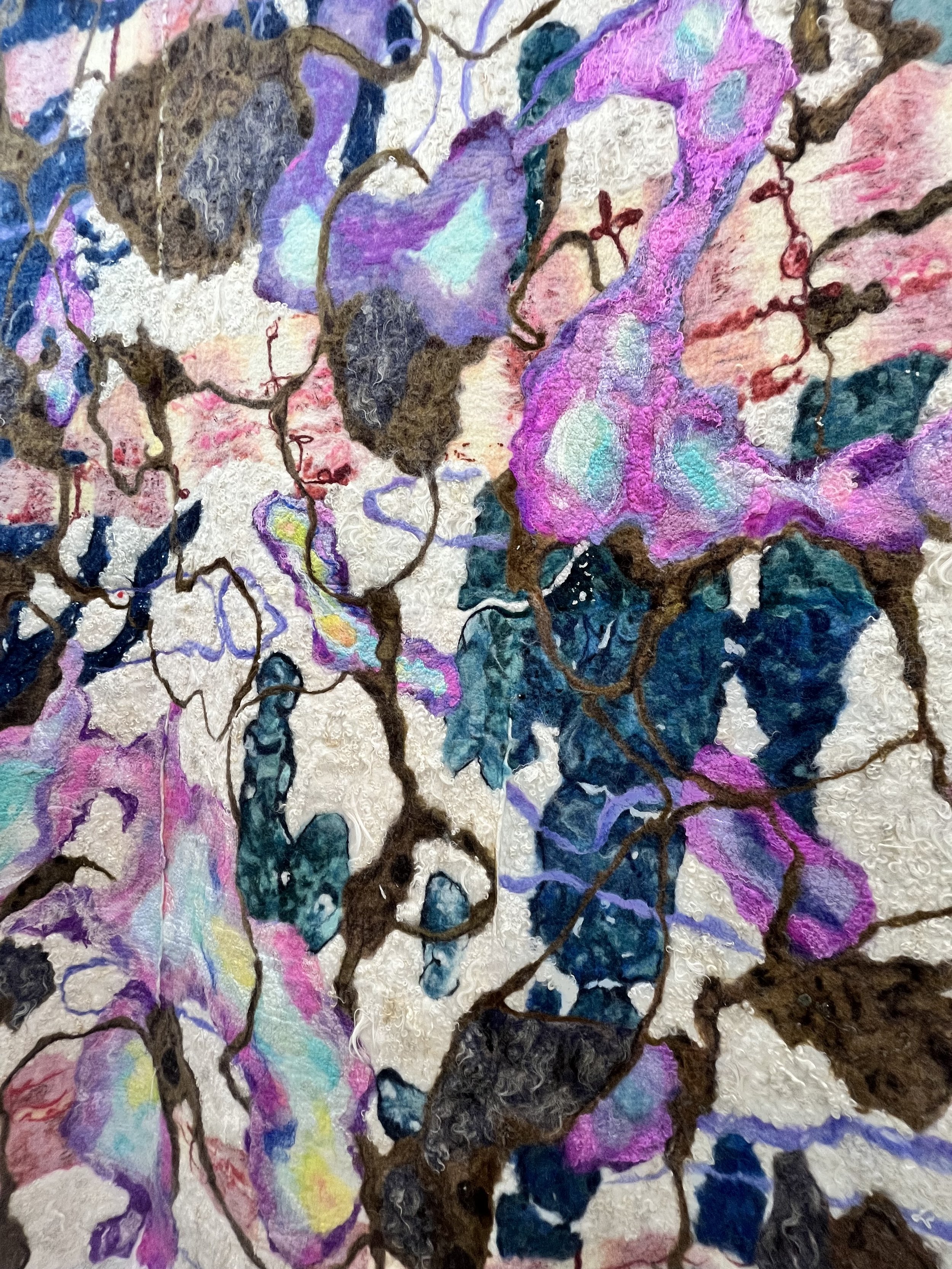Eroding the Nature-Culture Divide
An explosion of texture consumes the Mother/Land exhibition space at Murmurs LA. The show houses the work of nine female artists who enact feminist readings of landscape and ecology through their use of organic materials and embrace of historically feminized craft traditions like weaving and pottery. Taken as a whole, the artists of Mother/Land destabilize notions of a nature-culture divide by presenting human and biological subjects as unbounded and interconnected entities. While all of the works presented in the exhibition carry weight as discursively-rich objects, two compositions strike me as particularly illustrative of the show’s underlying ideological principles.
My attention was immediately drawn to Pauline Shaw’s The Tomb-Sweeper’s Mosquito Bite (2021), a tapestry composed of wool, cotton, silk, milk fibers, and bamboo fibers. These disparate threads coalesce into a colossal composition, formed by a matrix of smaller interwoven panels, which hang delicately from the ceiling. Detached from the walls of the institution, The Tomb-Sweeper’s Mosquito Bite becomes an organism onto itself, flowing gently with each subtle shift in airflow.
All over the composition, colorful, amorphous shapes meld into one another, mimicking firing neurons or congealing oils in their energized fluidity. Vibrant forms, which possess a toxic radiance in their pink, blue, and green gradients, jump off the tapestry into physical space, whereas darker brown and navy splotches of fabric recede. Such dramatic contrast between hyper-saturated and muted figures generates optical excitement.
Despite this, the tapestry ultimately draws one in more tactilely than visually. The rich surface’s miscellaneous fabrics curl and overlap into one another organically, resembling untreated wool on a sheep’s skin. Compared with 20th-century modernist tapestries by figures like Anni Albers, Shaw’s work leans into her chosen materials’ natural tendency to twist and grow haphazardly, resisting the imposition of a strict organizational logic.
To this end, natural forces are equally active as the hands of the artist in molding the appearance of The Tomb-Sweeper’s Mosquito Bite. Shaw thus proposes an anti-colonial conception of artistic identity as an intimate collaboration with nature rather than the manipulative rearrangement of its resources. Like the amorphous, interconnected shapes that occupy the composition, the artist is a dynamic being woven into an ever-shifting ecosystem.
Directly in front of Shaw’s tapestry sits Katie Grinnan’s 2018 sculpture Double, a life-sized depiction of a human body bisected by several overlaid, jagged waves. Earthy and mottled in its coloration, the sculpture is a composite of Friendly Plastic, synthetic sand, and earthen minerals harvested from Death Valley.
Through her fusion of organic and artificial materials, in which the difference between the two becomes indistinguishable, Grinnan’s sculpture renders human anatomy as a sprawling terrain. In doing so, the artist simultaneously personifies the desert as a living entity and dissolves preconceived boundaries of human subjecthood as separate from its surrounding environment.
Grinnan’s splaying and fragmentation of the human body carries a surrealist edge, which the work’s description makes explicit to viewers. The artist characterizes the pointed, rippling forms that erupt from the body as a “landscape formed from EEG data of 5 seconds of dreaming.” Calling attention to the figure’s absorption within the subconscious realm of dreams, Grinnan sculpts a human subject that is neither static nor universalized—rather, one that is inextricably bound to a certain identity and place. Her emphasis upon the sculpture’s material place of origin in Death Valley serves a similar effect.
In highlighting the particularities of Double’s Inception, Grinnan refuses to describe arbitrary, sweeping truths about the human experience through her work, opting instead to navigate contemporary circumstances of environmental degradation. The sculpture undoubtedly belongs to our present age of ubiquitous microplastics, as suggested by its somewhat uncomfortable mixture of manufactured toxicities with organic resources.
Double’s impure construction ultimately offers a critique of Western cultural scripts surrounding the environment. Grinnan refuses to construct a mechanically flawless human; rather, she breaks down notions of perfection. By intentionally sculpting a polluted body, Grinnan suggests that accepting impurity as an inescapable fact of life can offer new ways of interacting with the Earth that avoid its destruction. In refusing the rigid optimization of both nature and ourselves, our bodies might enter a state of dreamy harmony with the landscapes they inhabit.
The surreal quality of Double exemplifies the broader atmosphere of Mother/Land. Walking through the show, one feels as if they are immersed in an environment that is simultaneously separate from this world and derived from it. The existential environmental woes of our present become the scaffolding for new, fantastical realities. The act of feminist world-building thus offers an escape route from humanity’s current trajectory toward ecological collapse. Through loving craft labor, a more just future is born.
Mother/Land is on view at Murmurs from March 29 through May 10, 2025.
Edited by Jubilee Park






